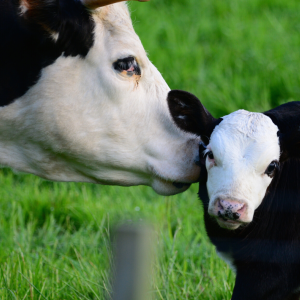
By Veterinary Surgeon Diane Watson

Pneumonia is one of the biggest health challenges we see in calves. Prevention is better than cure, and so preventative healthcare should always be the main aim to improve calf health. This is where calf lung scanning can become very beneficial.
Current methods of detecting pneumonia in calves relies on external visual indicators such as demeanour, difficulty breathing, nasal discharge, coughing and a high temperature. Early identification of pneumonia is crucial for successful treatment, but can be difficult when these current approaches fail to detect calves with sub-clinical pneumonia or those with lesions within the lungs. Only 35% of calves show clinical signs of pneumonia, meaning a large proportion of disease goes unnoticed and untreated until it’s too late.
Lung scanning involves using an ultrasound scanner, the same as that used for pregnancy detection in cows, to scan a calf’s chest. It allows us to visualise the lung tissue and assess if there are any consolidation (areas of infected lung that are not functional) indicating respiratory disease.
Consolidation of the lungs appears much earlier, up to a week, than classical clinical signs of pneumonia. This means that with lung scanning we are able to detect and treat cases of respiratory disease much faster than by using traditional detection methods. In many cases, this leads to shorter courses of antibiotics, and better resolution of infected tissue.
There are detrimental long term effects for affected calves, with impacts on growth rates, milk production and increased risk of early culling. Research has shown that lung consolidation within 8 weeks of life, results in a 500litres decrease in milk production in the first lactation alone. Additionally, lung consolidation can result in a 200g/day decrease in daily liveweight gain, which accumulated overtime is a very significant decrease in growth rate.
Practically, calf scanning can be utilised in multiple ways depending on requirements specific to different farms. It can be used reactively in the face of a pneumonia outbreak to determine the extent of the problem and assess how successful current control methods and treatments have been. In turn, by comparing lung health before and after management changes are implemented (such as vaccination programmes, housing modifications, or changes in colostrum and feeding management) we can determine their real-world effectiveness and fine tune strategies to suit each farm.
As a “one-off” for a cohort, calves at weaning can be scanned to assess for areas of consolidated lung that will lead to poor performance as an adult cow. Using this alongside additional information, such as health history, growth rates and genetic potential, appropriate breeding decisions can be made to select future replacement heifers entering the adult herd.
Finally, more regular scanning of calves a week prior to the time pneumonia clinical signs commonly occur can be implemented. This helps to identify those calves in the early stages of pneumonia, before signs develop, allowing prompt treatment and earlier resolution of disease to minimise long term impacts and reduce antibiotic use.
Lung scanning is quick to carry out - taking only 1-2 minutes per calf - and causes minimal stress to the animal. Typically calves are scanned around 4-6 weeks of age. The scanner is usually applied to both sides of the chest behind the elbow, without the need for clipping or sedation, and the results are immediate.
As with any tool, the key to success lies in using scanning as part of a broader calf health strategy. When combined with good colostrum management, appropriate vaccination, nutrition, and housing, lung scanning can significantly reduce the impact of respiratory disease on youngstock and improve long-term productivity.